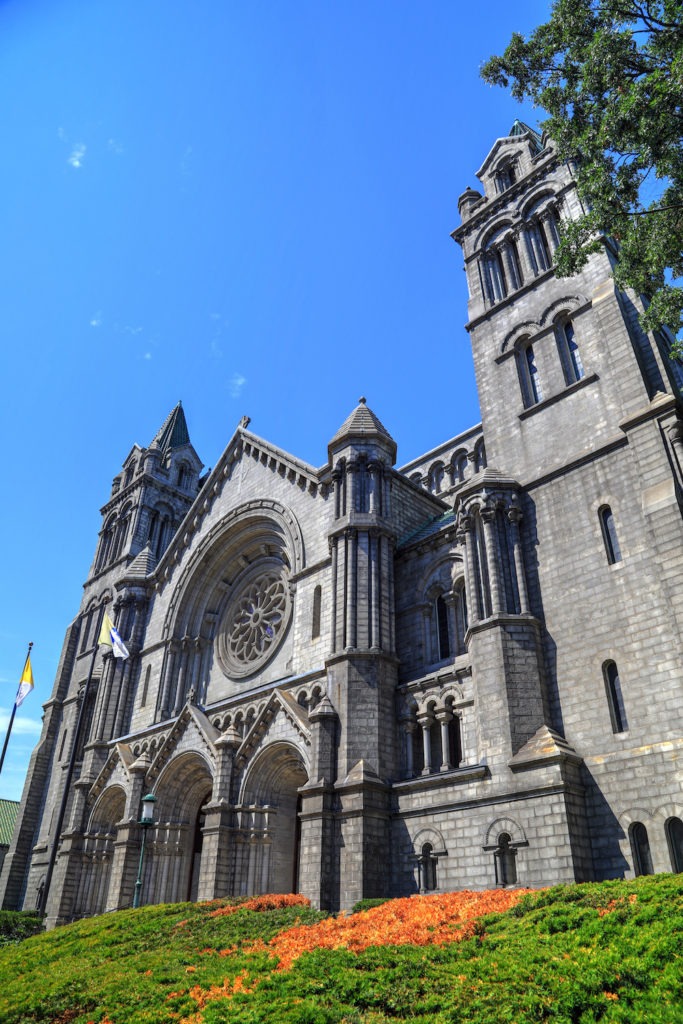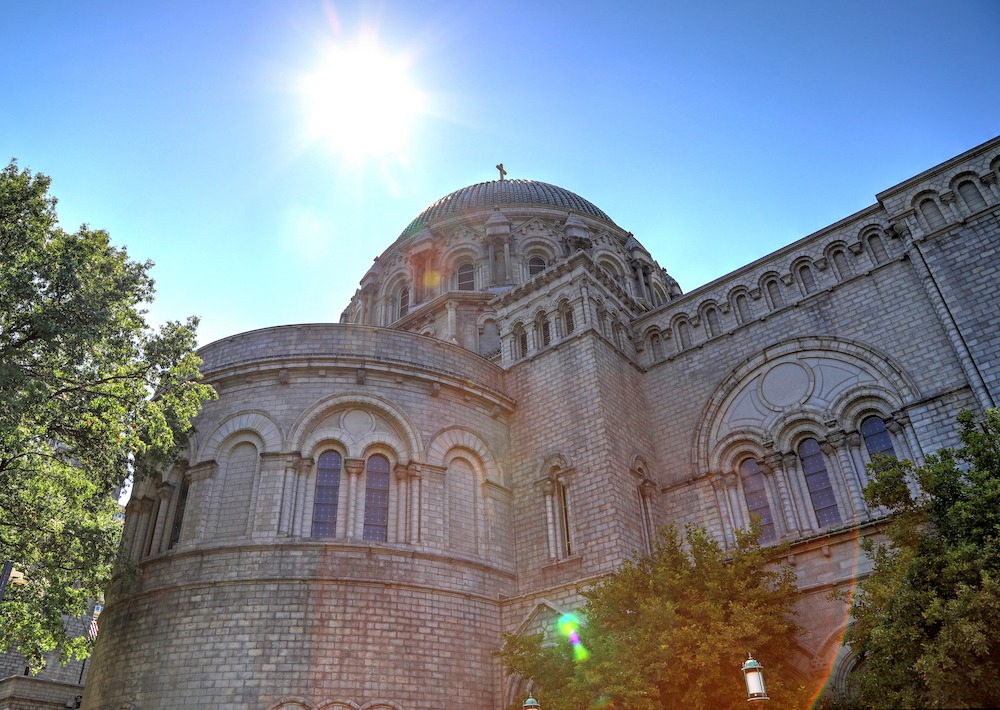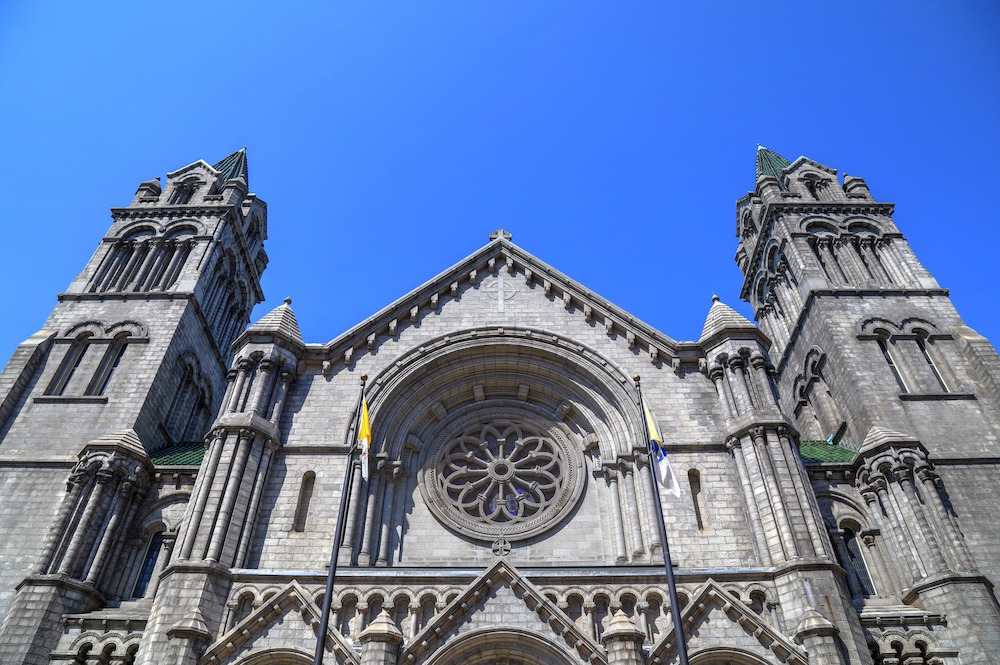New Cathedral Basilica of St. Louis Merges Old with New
Words: Ashley Johnson
Words: Ashley Johnson
Photos: JByard
The United States is fortunate to retain so many historical treasures that take us back to an earlier era and allow us to glean from our past lessons and ideas that help us mold and direct our future.
One of those historical treasures is the Cathedral Basilica of St. Louis, a more than 100-year-old neo-Byzantine Romanesque Revival cathedral completed in 1914. With more than 83,000-square-feet of Byzantine and Italian mosaics, four chapels, a soaring green dome, and massive double towers, the New Cathedral is a hallmark of the landscape in the central west end of St. Louis.
Before the New Cathedral
Before the construction of the new Cathedral Basilica of St. Louis, the city was home to only one cathedral, the Basilica St. Louis, King. At the time, St. Louis was burgeoning with scores of immigrants originating from western Europe.
Archbishop John J. Kain, a Roman Catholic priest, expressed the desire and need to replace the “Old Cathedral,” with a grander, more worthy structure for the great growing western city of St. Louis.
A cathedral fund was formed by Archbishop Peter Richard Kendrick, as well as a formal organization that promoted the necessity of the new cathedral.
At the time the cathedral fund was formed, the community of St. Louis was recovering from a catastrophic tornado that tore through the city in 1896 killing hundreds of people and destroying the landscape.
Nevertheless, in that same year, Archbishop Kain purchased land for the cathedral located at Lindell and Newstead. Soon after, in 1903, he passed away in St. Agnes’ Sanatorium after a long illness and was unable to see the project through.
Planning and administration of the cathedral were taken over by Archbishop John Joseph Glennon, who led its construction and design. Glennon, who later was elevated to Cardinal, is credited with bringing the project to fruition.
Breaking ground and constructing the New Cathedral
In 1906 the architectural firm Barnett, Hayes & Barnett was selected by Glennon to build the new Cathedral Basilica, with George D. Barnett leading the overall design. Although the ground was broken on May 1, 1907, the cornerstone was not laid until October 10, 1908.
The first mass held at the new cathedral took place on October 18, 1914, although full consecration of the building did not take place until June 29, 1926.
In addition to the overall design, Barnett also designed the main altar, the baldachino with a dome that echoes the main dome (a large canopy that goes over the altar), and the mosaics in the lower sanctuary, which were installed by the Gorham Company in 1916. Barnett also designed the Blessed Sacrament Chapel and the mosaics found there.
During a seven-year exterior renovation, architect Joseph Murphy of Murphy and Mackey of Saint Louis oversaw the program to repair and correct a problem with moisture that was disintegrating the granite walls and roof. Murphy also designed the mosaic shrine of Our Lady of Perpetual Help.
Mosaics of the new cathedral
The Cathedral Basilica contains one of the largest mosaic collections in the western hemisphere depicting scenes from the bible, the King of France, and stories from the history of St. Louis.
Starting in 1912, Byzantine glass tesserae mosaics and Italian-colored marble mosaics were added to the interior of the Cathedral Basilica and cover more than 83,000 square feet. About 41.5 million glass tesserae pieces make up the mosaics in more than 7,000 colors. Mosaics have continued to be added up until 1988 only pausing during the Great Depression and World War II.
All of the mosaics in the cathedral are Byzantine except the mosaics in the Blessed Virgin’s and All Saints’ chapels. Byzantine mosaics are known for small pieces of glass that are highly reflective. These pieces are made up of glass tesserae and gold leaf that add so much detail to the design.

Alternatively, Italian mosaics are made up of colored marble tesserae instead of glass, giving these mosaics muted colors, a duller quality, and less of a sheen.
The mosaics in the side chapels and sanctuary walls were designed and installed by Tiffany Studios while the main cathedral areas were done by August Oetken. A number of artisans helped to install the mosaics including the father and son team Paul and Arno Heuduck, who worked on the mosaics for nearly their entire lives.
Features of the New Cathedral
What makes this building a cathedral is the bishop’s chair or “cathedra” on the west side of the sanctuary.
The Cathedral Basilica is constructed out of granite and features three domes, two spires, and contains four chapels inside for 5,000 worshippers. Inside the cathedral is constructed from brick, marble, and mosaic tiles.
The central dome of the Cathedral Basilica rises 143 feet and features panels dedicated to the Holy Trinity, Ezekiel the Prophet, the woman of the Apocalypse, and Elias taken to heaven in a fiery chariot. Pendentives with mosaics of four angels portray the Old Testament, New Testament, Ecclesiastical Authority, and civil authority.
The Sanctuary Dome is decorated in mosaics that depict the 12 Apostles bearing symbols of their lives. Four pendentive mosaics show images of four doctors or teachers of the church, St. Cyril of Alexandria and St. John Chrysostom of the Eastern rite, St. Thomas of Aquinas, and St. Ambrose of the western rite.

The south soffit of the dome was completed in 1927 and features mosaics depicting the priesthood of the Old and New Testaments. Mosaics also portray the Passover feast, the sacrifice of Jesus, Last Supper.
Beneath the cathedral is housed a mosaic museum. Within the lower level, the museum displays how the mosaics were designed and installed. In addition to the museum is a crypt that holds the remains of St. Louis’ cardinals and archbishops.
The great cathedral Kilgen organ, now also housed in the mosaic museum beneath the cathedral, was dedicated by Glennon on the feast of St. Louis on August 15.
In 1999 Pope John Paul II visited the Cathedral and elevated it to the status of a Basilica. The throne he used during his visit can be found in the museum underneath the cathedral.
Chapels of the Cathedral Basilica
There are four chapels inside the new cathedral. The Blessed Sacrament Chapel is reserved for private prayer and features mosaic panels portraying the gift of the Eucharist. The ambulatory ceiling is red with angels holding instruments to acknowledge the suffering of Christ.
The All Saints Chapel is the work of Louis Comfort Tiffany and is dedicated to the early classification of saints as either apostles, confessors, martyrs, or virgins.
The All Souls Chapel is designed in the Viennese Reconstructionist architectural style, using black marble to symbolize death and white marble resurrection or eternal life. This chapel also stands over the burial place of several archbishops and cardinals including Cardinal Glennon, Cardinal Ritter, Cardinal Carberry, and Archbishop May.
The fourth chapel, created by Tiffany Company of New York in the Italian style, is Our Lady, Mary Chapel. Mosaics here portray Mary’s presentation, Annunciation, visitation to Elizabeth, and the Assumption.

The Cathedral Today
The Cathedral Basilica of St. Louis today is a modern, highly functional parish that engages with the community and its worshippers in a number of ways including offering the ability to live-stream its masses and worshipping services, as well as concerts and other events. Masses are held all days of the week, including weekends. The cathedral also acts as a venue for weddings, funerals, first communions, baptisms, holy orders, confirmation.
A highlight of the cathedral is its adult choir and children’s choir. The children’s choir was created in 1998 and is composed of children from parishes throughout the 11 counties of the archdiocese of St. Louis. Participants are chosen by audition, as is the adult choir, and provides children the opportunity to develop their voices, sharpen their musical skills, and sing music in liturgical and concert settings.
In addition to engaging parishioners through music, the cathedral boasts a Jubilee Prayer Garden, completed in the summer of 2000, that extends from the west side of the cathedral to the east side of the parish rectory. This garden offers a peaceful place for worshippers to congregate as well as allowing the fellowship of friends.
In addition to regularly performing at Archdiocesan liturgies, special events, and concerts, the children’s choir also performed during Pope John Paul II’s visit in 1999.
Tours of the cathedral are available, both self-guided and guided, and offer visitors the best opportunity to learn about the history behind the Cathedral, its architecture, and its mosaics.